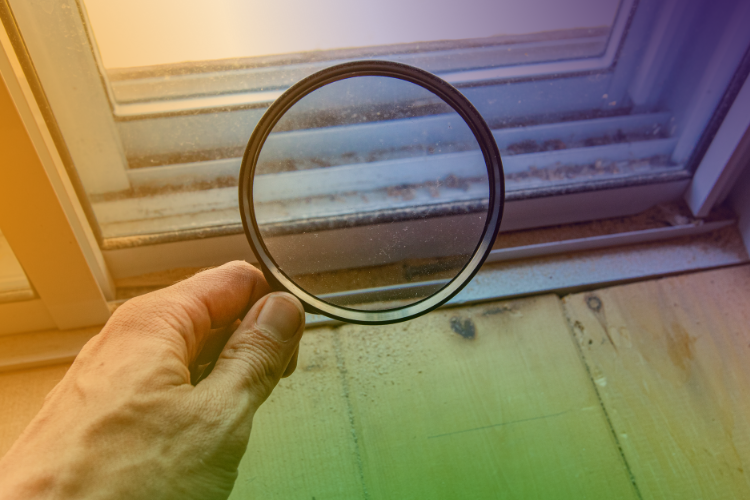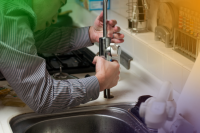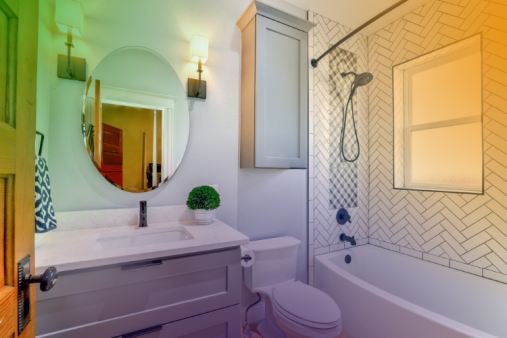Dampness in the home can cause a variety of problems, from musty odors to damage to walls and furniture. Here are some steps you can take to deal with damp in your home:
-
Identify the source of the dampness: Before you can effectively deal with dampness, you need to find out where it's coming from. Common sources include leaks in the roof or plumbing, condensation from cooking or showering, and rising damp from the ground.
-
Improve ventilation: Good ventilation can help to reduce dampness in the home. Make sure that your home has adequate ventilation, particularly in areas like bathrooms and kitchens where moisture is often present. You can also install extractor fans to help remove excess moisture.
-
Use a dehumidifier: A dehumidifier can be an effective way to remove excess moisture from the air. They work by drawing in damp air and removing the moisture, then releasing dry air back into the room.
-
Repair leaks: If you have leaks in your roof or plumbing, it's important to get them repaired as soon as possible. This will help to prevent further damage to your home and reduce the risk of mold growth.
-
Treat mold: If you have mold growth in your home, it's important to treat it as soon as possible. You can use a bleach solution to clean the affected area, or you may need to call in a professional to help remove the mold.
-
Insulate your home: Insulating your home can help to reduce dampness by keeping the warm air in and the cold air out. This can be particularly effective in older homes that may not have adequate insulation.
By taking these steps, you can help to reduce dampness in your home and create a healthier living environment.
Identifying the sources of dampness in your home
Identifying the source of dampness in your home is important in order to effectively deal with the problem. Here are some steps you can take to identify the source of dampness:
-
Check for leaks: Look for any signs of leaks in your roof, walls, or plumbing. Check for water stains or discoloration on walls or ceilings, and listen for any sounds of dripping water. If you find a leak, get it repaired as soon as possible.
-
Check for condensation: Condensation can occur when warm, moist air meets a cooler surface, such as a window or wall. Check for signs of condensation in areas such as bathrooms and kitchens, where moisture is often present. Look for water droplets on windows or walls, and feel for dampness on surfaces.
-
Look for signs of rising damp: Rising damp can occur when moisture from the ground seeps up through walls and floors. Look for damp patches on walls or floors, particularly in lower areas of the home. Check for any signs of mold or mildew growth, as these can be indicators of rising damp.
-
Check for ventilation issues: Poor ventilation can lead to dampness in the home. Look for areas where air may be trapped, such as behind furniture or in closets. Check that extractor fans and vents are working properly in bathrooms and kitchens.
-
Consider the climate: Some areas are more prone to dampness than others, particularly those with high humidity or a lot of rainfall. If you live in a damp climate, take extra steps to prevent dampness in your home.
By identifying the source of dampness in your home, you can take appropriate steps to address the problem and prevent further damage. If you're unsure about the cause of dampness in your home, consider contacting a professional for help.
Improving ventilation in your home
Improving ventilation in your home can help to reduce dampness and improve indoor air quality. Here are some steps you can take to improve ventilation:
-
Open windows: One of the easiest ways to improve ventilation is to open windows and doors to let in fresh air. This can be particularly effective on dry, breezy days.
-
Install extractor fans: Extractor fans can help to remove moisture and odors from areas such as bathrooms and kitchens. Make sure that fans are properly installed and vented to the outside.
-
Use trickle vents: Trickle vents are small vents that allow a continuous flow of fresh air into your home. They can be installed in windows or walls and can be adjusted to control the flow of air.
-
Use ceiling fans: Ceiling fans can help to improve air circulation and reduce the need for air conditioning. Make sure that fans are properly installed and set to rotate in a counter-clockwise direction during the summer months.
-
Use natural ventilation: Natural ventilation involves using the natural movement of air to improve ventilation. This can be achieved by creating openings on opposite sides of a room, such as opening windows or doors on opposite walls.
-
Inspect air ducts: If your home has a central heating or cooling system, make sure that air ducts are properly sealed and free from obstructions.
By improving ventilation in your home, you can help to reduce dampness and improve indoor air quality. Consider which methods will work best for your home and lifestyle.
Using a dehumidifier
Using a dehumidifier can be an effective way to reduce excess moisture in your home. Here are some steps you can take to use a dehumidifier:
-
Choose the right size: Dehumidifiers come in different sizes, so it's important to choose the right one for your space. Check the manufacturer's recommendations for the appropriate size for your room or home.
-
Place the dehumidifier in the right location: It's important to place the dehumidifier in the area where you want to reduce moisture. This is often in a basement, laundry room, or other damp area. Make sure the dehumidifier is placed on a flat, stable surface.
-
Adjust the settings: Most dehumidifiers have adjustable settings that allow you to control the level of humidity in your home. Set the dehumidifier to your desired level of humidity, usually between 30-50%.
-
Empty the water tank: As the dehumidifier removes moisture from the air, it collects water in a tank. Make sure to empty the tank regularly, usually every day or two depending on the level of humidity.
-
Clean the dehumidifier: It's important to clean the dehumidifier regularly to prevent the growth of mold or bacteria. Check the manufacturer's recommendations for cleaning and maintenance.
By using a dehumidifier, you can help to reduce excess moisture in your home and prevent problems such as mold and mildew growth. Make sure to follow the manufacturer's recommendations for use and maintenance.
Treating mold in your home
Mold can be a serious problem in homes, as it can cause health issues and damage to the structure. Here are some steps you can take to treat mold in your home:
-
Identify the source of moisture: Mold needs moisture to grow, so it's important to identify the source of the moisture and fix it. This could be a leaky roof or plumbing, poor ventilation, or high humidity levels.
-
Wear protective gear: Before you begin treating mold, it's important to protect yourself. Wear gloves, a face mask, and eye protection to avoid contact with mold spores.
-
Clean affected areas: Use a solution of bleach and water (1 cup of bleach to 1 gallon of water) to clean affected areas. Make sure to follow safety instructions on the label of the bleach container. Use a stiff brush to scrub the area and then rinse with clean water.
-
Dry the area: After cleaning, dry the area thoroughly to prevent moisture from returning. Use a fan or dehumidifier to speed up the drying process.
-
Discard contaminated items: If mold has contaminated items such as carpeting or upholstery, it's often best to discard them.
-
Prevent future mold growth: Take steps to prevent future mold growth by fixing any sources of moisture and increasing ventilation in the affected area.
-
Seek professional help: If you have a large mold problem or are unsure about how to safely treat it, consider contacting a professional mold remediation service.
By treating mold in your home, you can help to protect your health and the health of your family, as well as prevent damage to your home. Make sure to take the necessary safety precautions and follow the steps above to effectively treat mold.







